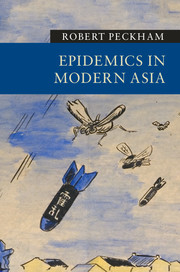2 - Cities
Published online by Cambridge University Press: 05 May 2016
Summary
How has urbanization influenced the diffusion of disease? To what extent have epidemics shaped urban space and determined how cities are experienced? This chapter addresses these interrelated questions by considering epidemics in relation to a number of cities. Each of the four cities considered here – Batavia, Hanoi, Singapore, and Bombay – are colonial cities, in as much as their development took place within the context of colonization. The term ‘colonial city,’ however, is problematic, ‘blurring as many features of the reality as it illuminates.’ What is a colonial city? Most cities in history might in some sense be viewed as colonial in that they have subordinated their agrarian hinterlands in a manner analogous with a colonizing power. ‘The local relationship of town-to-country,’ Anthony King has noted, ‘becomes the metropolis–colony connection on a world scale.’ At the same time, municipal authorities in the second half of the nineteenth century mobilized many of the same instruments in order to regulate the behavior of native city dwellers at home and abroad. To this extent, at least, ‘Bombay and Manchester were “colonized” in the same way.’
The aim in this chapter is to chart different epidemic histories through the biographies of Asian cities from the late eighteenth to the early twentieth century in order to illuminate facets of the interrelationship between epidemic disease and urbanization. As a process, urbanization may be defined as the spatial concentration of a population that results from the centralization of government and the clustering of economic activity. In the previous discussion, we considered the port cities of Manila, Nagasaki, and Hong Kong as contact zones: sites of epidemics where different scales of mobility converged, generating friction and violence. In this chapter, I develop these ideas to show how epidemics both propelled and stymied urban growth, even as cities produced different kinds of epidemic threats. In a European context, the historian Richard Evans has explored the inner life of Hamburg in relation to cholera epidemics – and in particular the epidemic of 1892 – demonstrating how disease highlighted social inequalities, shaped the city's municipal politics, and above all created the conditions for political reform. Similarly, each of the four case studies in this chapter considers specific aspects and moments in the history of a city to shed light on the management of urban space and infectious disease.
- Type
- Chapter
- Information
- Epidemics in Modern Asia , pp. 95 - 141Publisher: Cambridge University PressPrint publication year: 2016



